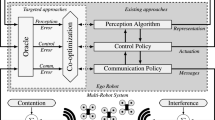Abstract
In multi-robot systems, each robot needs to have the position and pose information of itself and that of the other cooperative robots. This paper presents a synchronous distributed positioning system that uses a multi-code ultrasonic sensor network and a compensation algorithm using a Kalman filter. The bearings of robots are computed by using their position changes, and then compensated for by using the Kalman filter. The ZigBee sensor network protocol is used for communication among the robots and for the synchronization of the ultrasonic transmission timing. The experimental results show that our system positions multiple robots synchronously without any configured infrastructures. The results have a better accuracy and less accumulative error than those found in positioning systems without compensation.
Similar content being viewed by others
References
G. Welch and G. Bishop, “An introduction to the Kalman filter,” UNC-Chapel Hill, TR 95-041, July 24, 2006.
I. A. Getting, “The global positioning system,” IEEE Spectrum, vol. 30, no. 12, pp. 36–47, Dec. 1993.
C.-J. Wu and C.-C. Tsai, “Localization of an autonomous mobile robot based on ultrasonic sensory information,” Journal of Intelligent and Robotic Systems, vol. 30, pp. 267–277, 2001.
H. S. Shim, M. J. Jung, H. S. Kim, I. H. Choi, and J. H. Kim, “Development of vision-based soccer robots for multi-agent cooperative systems,” MIROSOT Proceedings, pp. 29–35, 1997.
C. Jennings, D. Murray, and J. J. Little, “Cooperative robot localization with vision-based mapping,” Proc. of IEEE Int. Conf. on Robotics and Automation, vol. 4, pp. 2659–2665, Mar. 1999.
J. D. McLurkin, Stupid Robot Tricks: A Behaviorbased Distributed Algorithm Library for Programming Swarms of Robots, Submitted for the Degree of Master, MIT, May 2004.
S. I. Roumeliotis and G. A. Bekey, “Distributed multirobot localization,” IEEE Trans. on Robotics and Automation, vol. 18. no. 5, pp. 781–795, Oct. 2002.
K. Langendoen and N. Reijers, “Distributed localization in wireless sensor networks,” Proc. of IEEE Int. Conf. on Muultisensor Fusion and Integration for Intelligent Systems, Aug. 2008.
R. Grabowski and P. Khosla, “Localization techniques for a team of small robots,” Proc. of the IEEE/RSJ International Conference on Intelligent Robots and Systems, Maui, HI, vol. 29, no. 3, pp. 1067–1072, Oct. 2001.
L. Kleeman, “Optimal estimation of position and heading for mobile robots using ultrasonic beacons and dead-reckoning,” Proc. of the IEEE Int. Conf. on Robotics and Automation, Nice, France, May 1992.
J. Manuel Villadangos, J. Urena, M. Mazo, A. Hernandez, F. Alvarez, J. J. Garcia, C. De Marziani, and D. Alonso, “Improvement of ultrasonic beaconbased local position system using multi-access techniques,” Proc. of Intelligent Signal Processing, IEEE International Workshop, pp. 352–357, Sept. 2005.
J. Kwon, Implementation of Simultaneous Driving Ultrasonic Local Positioning System Using Multi-Codes, Submitted for the Degree of Master, Pusan National University, 2008.
B. Barshan and B. Ayrulu, “Performance comparison of four time-of-flight estimation methods for sonar signals,” IEEE Electronics Letter, vol. 34, no. 4, pp. 1616–1617, Aug. 6 1998.
Author information
Authors and Affiliations
Corresponding author
Additional information
Recommended by Editorial Board member Myotaeg Lim under the direction of Editor Jae-Bok Song. This work was supported by the Grant of the Korean Ministry of Education, Science and Technology (The Regional Core Research Program/Institute of Logistics Information Technology).
Woo-sung Moon received his B.S. and M.S. degrees in 2007 and 2009, respectively, and is currently working toward a Ph.D. degree in the School of Electrical Engineering, Pusan National University. His research interests include collective intelligent systems.
Bong Soo Cho received his B.S. and M.S. degrees in 2004 and 2006, respectively, and is currently working toward a Ph.D. degree in the school of Electrical Engineering, Pusan National University. His research interests include nonlinear control, adaptive control, and system identification
Jin Won Jang received his B.S. and M.S. degrees in 2005 and 2007, respectively, and is currently working toward a Ph.D. degree in the school of Electrical Engineering, Pusan National University. His research interests include vision system, and adaptive control.
Kwang Ryul Baek received his B.S. degree in Electrical and Mechanical Engineering from Pusan National University in 1984. He received his M.S and Ph.D. degrees from KAIST. He joined Turbotech Company as the head of development from 1989 to 1994. Now, he is a professor in Pusan National University. His research interests include digital signal processing, control system, and high-speed circuit systems.
Rights and permissions
About this article
Cite this article
Moon, Ws., Cho, B.S., Jang, J.W. et al. A multi-robot positioning system using a multi-code ultrasonic sensor network and a Kalman filter. Int. J. Control Autom. Syst. 8, 1349–1355 (2010). https://doi.org/10.1007/s12555-010-0622-9
Received:
Revised:
Accepted:
Published:
Issue Date:
DOI: https://doi.org/10.1007/s12555-010-0622-9




